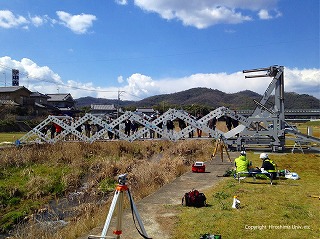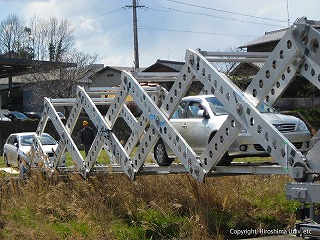. 
Bridge Science and Technology
Mobile Bridge
1. Guide book of MB(モバイルブリッジMBのガイド) [new]
2. Quick report of the damaged bridges for the western Japan flood disaster(西日本豪雨災害の橋梁被害)
There were the broken bridges by Natural Disasters investigating
in vewpoints of Structural Satbility
There
are several types of natural disasters, such as earthquakes, floods, tsunamis
and landslides. Japan has a long history of devastating disasters which have
killed thousands of people and severely destroyed the infrastructure. In 1995,
the Great Hanshin Awaji earthquake occurred, destroying numerous buildings and
infrastructure. Portions of the country are still recovering from the Tohoku
earthquake and tsunami of 2011. In recent years, several massive bridges have
been damaged by various typhoons in local areas of Japan such as Hokkaido,
Tohoku, and Kagoshima.
Natural
disasters can occur anywhere in the world and pose a threat to our lives. In
the aftermath of a natural disaster, among the infrastructure, the rapid recovery
of bridges is required. Repairing the damaged infrastructure is of utmost
importance, because this not only aids evacuation but also allows relief to be provided
to local communities. However, numerous risks and restrictions are present
within the disaster zones. Even if a prefabricated bridge is used in an emergency,
it takes a week or more until it is in a usable state. Because heavy machinery
and emergency vehicles may be unable to access the site, recovery work may be
delayed. In certain situations, an emergency bridge could be needed even in
locations where professional engineers are not available to construct them. Furthermore,
secondary hazards caused by localized damage could
probably impede any rescue operations. These situations raise the question, “which
useful activities can be performed in the immediate aftermath of a natural
disaster?".
In this study, basic mechanisms for the buckling of a thin cylindrical
shell under torsional loading are reviewed from a post-buckling perspective.
Deflections are considered extensively into the large-deflection range to the
point that the shell is allowed to fold to a flat two-dimensional form, in a
mechanism reminiscent of a deployable structure. Herein, critical and initial
post-buckling effects are explored through concepts of energy minimization and
hidden symmetries. For its comparison with the final large-deflection folded
shape, a truss element program is employed. It is shown that, as buckling
develops, the mode shape must change to accommodate both the symmetry-breaking
aspects of the predominately inward deflection and the rotation of peak and
valley lines of the buckle pattern necessary to accommodate the geometry of the
final folded shape. The concept behind the structure has been inspired from two
different forms of structural design techniques, namely, Origami which is the
art of paper folding, and scissor mechanism, which is a principle using linked,
folding supports in a criss cross 'X' shaped pattern as a basic unit in the
structural system. A novel structural system is proposed which has the
advantages of both the techniques and simultaneously serves the specific
purpose of providing relief for displaced people in times of need and in
emergency situations. A scissor structure is employed an Origami-inspired
foldable and/or deployable and movable bridge is used as a Mobile bridge. This
implies that it is useful to create a bridge construction using a folding
mechanism based on the academic science of Origami skills. It might be
significant to discover the essential core of an ``Origami-inspired more useful
industrial deployable bridge".
In the
field of bridge engineering, several studies have discussed the merits of
modular bridges [1] and the use of lightweight materials, such as fiber-reinforced
plastic (FRP) [2] or air tubes [3]. Although these propositions allow the rapid
construction of bridges, there remain various problems regarding the creation
of large construction yards and use of heavy industrial machinery. However, any
rescue technology should have a low level of complexity and high degree of resilience,
to enable its deployment even by unqualified personnel. Hence, we propose a new
type of foldable and deployable bridge traded as Mobile Bridge (hereinafter
referred to as “MB”) (Japan Patent No.2006-037668 [4], PCT WO2015/193930A1 [5] including
European Patents. The MB can be deployed and folded quickly owing to a scissor
mechanism which allows for a highly efficient construction and easy
transportation. The idea for this new bridge is based on the academic studies
on post-buckling using Origami fundamentals [6]
and [7].
In previous studies of the MB [8]-[10], the mechanism and design concept
were evaluated via numerical finite element analysis followed by a fundamental static-loading test using a
small experimental bridge. The current research reviews the field testing of
the latest MB in a real river and its
fundamental experimental and numerical results using a full-scale experimental
MB. Experimental testing includes strain and acceleration measurements in free
and forced loading conditions. From these results, it is possible to estimate the
basic dynamic characteristics of the bridge. In addition, in order to provide the
basis for development of new methods for structural reinforcement and
suppression of vibrations, various numerical models are designed. The conducted
research allows for a better and safer MB to be designed.
全に、瞬速に、架橋するために・・・


References
[1] G. R. Thomas and B. J. Sia, A rapidly deployable bridge system, Structures Congress 2013, 2013, pp. 656-667.
[2] G. Sedlacek and H. Trumpf, Development of a light-weight emergency
bridge, International Conference on High Performance Materials in
Bridges, 2003, pp. 150-161.
[3] R. H. Luchsinger, A. Pedretti, P. Steingruber and M. Pedretti, The
new structural concept Tensairity: Basic principles, Progress in
structural engineering, mechanics and computation, 2004, pp. 323-328.
[4] I. Ario, Structure with the expanding and folding equipment as a patent (No.2006-037668) registered in 2012, Japan.
[5] SCISSORS-TYPE RETRACTABLE STRUCTURE, Patent Publication Number: WO2015/193930A1.including registration of EP, 2015.
[6] G. W. Hunt and I. Ario, Twist buckling and the foldable cylinder:
an exercise in origami, Int. J. of Nonlinear Mechanics, 40(6), 2005,
pp. 833-843.
[7] P. Pawlowski, C. Graczykowski, J. Holnicki-Szulc, I. Ario, Smart,
deployable skeletal structures for safety engineering, The proceedings
of the 6th ECCOMAS Thematic Conference on Smart Structures and
Materials, 2013, pp. 1-10.
[8] I. Ario, M. Nakazawa, Y. Tanaka, I. Tanikura and S. Ono,
Development of a prototype deployable bridge based on origami skill,
Automation in Construction, Vol. 32, 2013, pp. 104-111. doi:
10.1016/j.autcon.2013.01.012
[9] M. Nakazawa and I. Ario, Structural Characteristics of Scissors
Type - Emergency Bridges, 5th Australian Small Bridges Conference,
Australia, 2012.
[10] Y. Chikahiro, I. Ario, M. Nakazawa, S. Ono, J. Holnicki-Szulc, P. Pawlowski and C. Graczykowski, A. Watson,
Experimental and numerical study of full-scale scissor type bridge, Automation in Construction, Vol. 71, 2016, pp. 171-180.
[11] E. P. Pinero, Three Dimensional Reticular Structure, United States Patent 3, 185, 164, 1965.
[12] T. R. Zeigler, Collapsible Self-supporting Structure, United States Patent 3, 968, 808, 1976.
[13] F. Escrig, Design of Expandable Special Grids, IASS NIladrid, Vol. 4, 1989.
[14] Y. Hahawa, M. Saitoh, A. Okada and N. Miyasato, Basic Study on
Structural Characteristics of String Scissors Structure, Part1 Proposal
of String Scissors Structure and Possibility of PS Introduction,
Summaries of technical papers of annual meeting Architectural Ins. of
Japan, 2001.
[15] B. Glisic, A. Sigrid and S. Peter, Structural analysis and
validation of a smart pantograph mast concept, Computer - Aided Civil
and Infrastructure Engineering, Vol. 28. Issue 9, 2013, pp. 651-665.
doi: 10.1111/mice.12013
[16] I. Ario, Y. Chikahiro, I. Tanikura, S. Onno, M. Nakazawa, S.
Nakatani, K. Yamada, S. Nakamura, Y. Tanaka, R. Tsubaki, S. Matsumoto,
K. Adachi, Consider recovering method by mobile bridge how to install a
disaster, Proc. of the 7th special symposium for reducing disaster,
JSCE, at Kumamoto, 2016.12
[17] Engineers create emergency origami bridge, Science and Environment of BBC news 23 July 2015,
http://www.bbc.com/news/science-environment-33625724
[18] New bridge unfolds in japan, The magazine of the american society of civil engineers, 18th August 2015,
http://www.asce.org/magazine/20150818-new-bridge-unfolds-in-japan/
Contact by e-mail: seto.we@gmail.com

